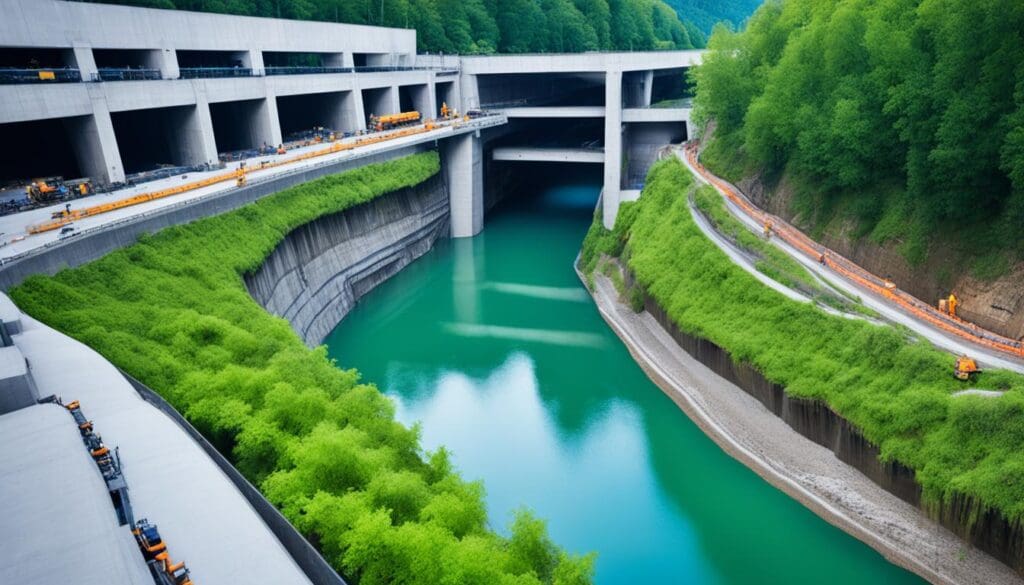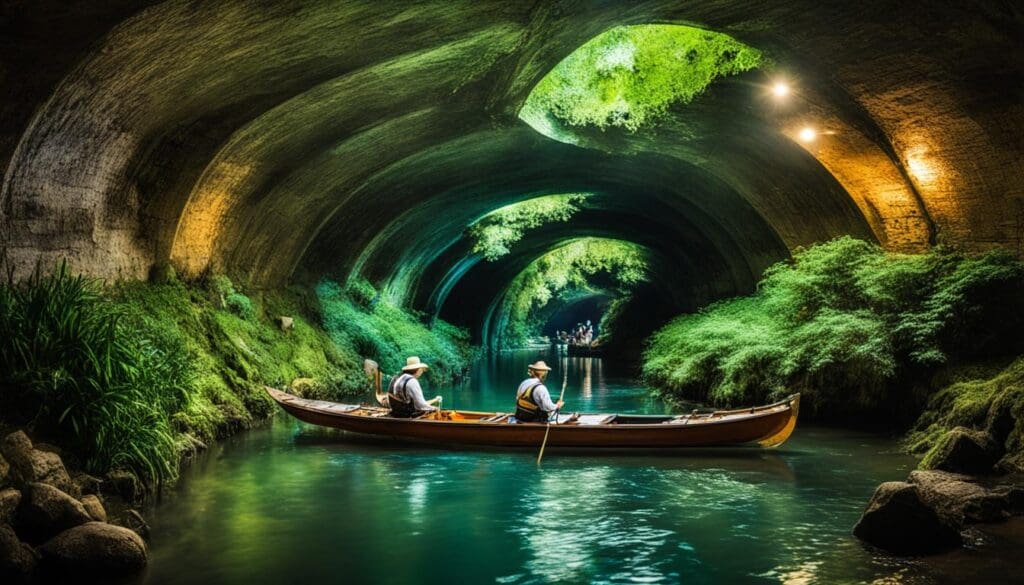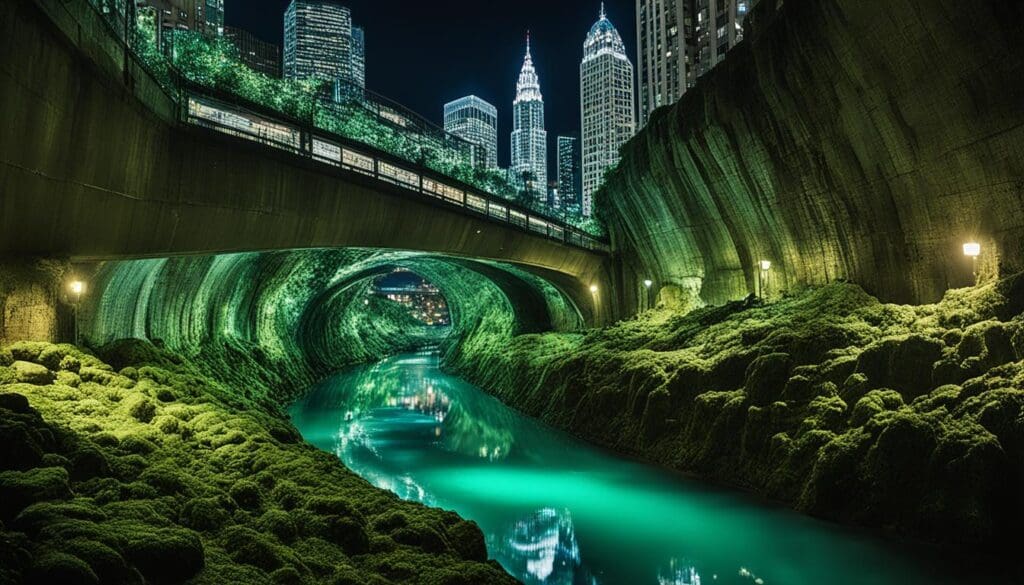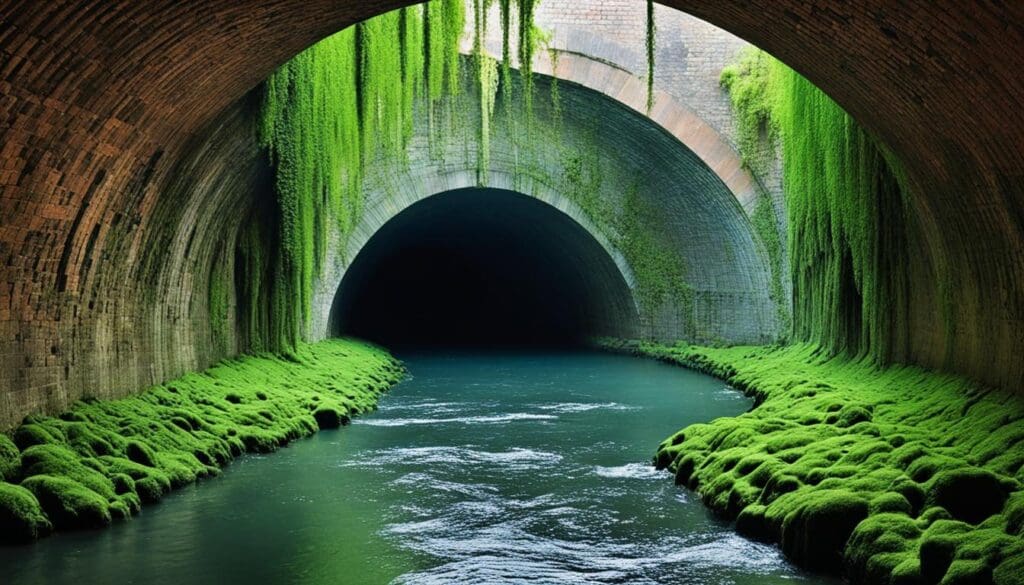Did you know that beneath the bustling streets of Buenos Aires lie hidden rivers, flowing silently and captivating the imagination of locals and visitors alike? These subterranean waterways have a fascinating history and hold secrets waiting to be discovered. So, what lies beneath Buenos Aires’ vibrant surface?
Buenos Aires is not only a vibrant metropolis but also a city with a unique underground world. Its subterranean rivers have shaped the city’s landscape and culture, making it an extraordinary destination to learn Spanish while immersing yourself in its mysteries. And if you’re looking for another remarkable place to master the Spanish language, consider Malaga, a city with its own hidden treasures and a rich historical backdrop.
In this article, we will delve into the enigmatic world of Buenos Aires’ subterranean rivers and explore the history, exploration, and cultural significance of these hidden waterways. We will also discuss the challenges of maintaining and preserving them, as well as the efforts being made to protect these natural wonders. Additionally, we’ll provide tips for those who wish to embark on their own underground adventure. Let’s embark on this journey of discovery and unravel the mysteries of Buenos Aires’ subterranean rivers.
Aprender Español es Facil!
The History and Origins of Buenos Aires Subterranean Rivers
The subterranean rivers of Buenos Aires have a rich history and intriguing origins. These hidden waterways provide a glimpse into the city’s ancient past and the geological forces that shaped its landscape. Millions of years ago, when Buenos Aires was submerged under the sea, these underground waterways began to form.
As the sea gradually receded and the land rose, the rivers became buried beneath layers of sediment, remaining hidden from view. Over time, these subterranean rivers carved their paths through the bedrock, creating a complex network that snakes beneath the bustling streets of Buenos Aires.
To visualize the magnitude and interconnectedness of Buenos Aires’ subterranean rivers, refer to the table below:
| River | Length (km) | Main Route |
|---|---|---|
| Rio de la Plata | 290 | South Atlantic Ocean to Buenos Aires |
| Rio Matanza-Riachuelo | 64 | Tigre River to Riachuelo Estuary |
| Rio Reconquista | 80 | San Miguel del Monte to Rio de la Plata |
This table highlights some of the prominent subterranean rivers in Buenos Aires, showcasing their lengths and main routes. It’s a testament to the complexity and extent of these hidden waterways, which continue to play a significant role in the city’s hydrological system.
The image above provides a visual representation of the underground waterways in Buenos Aires. This captivating view reveals the intricate network of rivers flowing beneath the vibrant city, giving us a glimpse of the hidden world beneath our feet.
Exploring the Aqueducts of Buenos Aires
One of the most fascinating aspects of Buenos Aires’ subterranean rivers is the intricate network of aqueducts that transport water throughout the city. These aqueducts, some of which date back centuries, provide a unique opportunity for exploration. From hidden chambers to intricate tunnels, uncovering the secrets of the aqueducts is an adventure like no other.
Imagine stepping into the depths of Buenos Aires, beneath the bustling streets, and discovering a labyrinthine system of aqueducts that have silently served the city for generations. These aqueducts, built with incredible precision and engineering prowess, not only supply water but are also a testament to the city’s rich history.
As you delve deep into the aqueducts, you’ll find yourself surrounded by awe-inspiring architecture and a network of tunnels that form a complex web beneath the city’s surface. The experience is both exhilarating and humbling, as you witness the remarkable engineering feats of the past.
Explorers and adventurers play a crucial role in documenting and mapping these hidden aqueducts. By venturing into the depths, they uncover forgotten chambers, underground rivers, and intricate passages that allow water to flow seamlessly across the city.
The aqueducts offer a window into Buenos Aires’ history, providing a glimpse into the architectural and engineering marvels of the past. By exploring these hidden wonders, we gain a greater appreciation for the city’s intricate urban infrastructure and the significance of its subterranean rivers.
To give you a better understanding of the astonishing complexity and scale of these aqueducts, take a look at the following table:
| Aqueduct | Construction Year | Length (in miles) |
|---|---|---|
| Aqueduct A | 1698 | 7.2 |
| Aqueduct B | 1750 | 12.5 |
| Aqueduct C | 1832 | 9.8 |
| Aqueduct D | 1910 | 15.3 |
These numbers showcase the significant scale of the aqueducts and underline the engineering prowess required to construct them. The aqueducts served as the lifelines of the city, ensuring a steady supply of water for various purposes.
Exploring the aqueducts is not only an adventure in itself but also a chance to appreciate the ingenuity of past generations. From the intricate arches and vaulted ceilings to the steady flow of water, each step into the underground world of Buenos Aires’ aqueducts unveils a remarkable story of human triumph.
As you embark on your journey through the aqueducts, remember to tread lightly and with respect for this hidden treasure. With ongoing efforts to preserve and conserve these historical structures, future generations will have the opportunity to continue the exploration of Buenos Aires’ subterranean rivers.
The Role of Subterranean Rivers in Buenos Aires’ Urban Water Systems
The subterranean rivers of Buenos Aires play a vital role in the city’s urban water systems. With their hidden currents flowing beneath the bustling streets, these underground waterways provide essential services that contribute to the sustainability and functioning of the city.
One of the key functions of the subterranean rivers is to regulate the flow of water throughout the city. As rainwater and runoff enter the underground system, the rivers act as natural conduits, distributing water to various parts of Buenos Aires. By dynamically managing the water flow, these hidden rivers prevent flooding and help maintain a balanced water supply for the city’s residents.
Furthermore, the subterranean rivers serve as a sustainable source of water for Buenos Aires. As the rivers traverse beneath the urban landscape, they collect groundwater, which can then be tapped into for the city’s water supply. This reliance on underground aquifers ensures a steady and reliable source of water, even during periods of drought or water scarcity.
The contribution of the subterranean rivers to Buenos Aires’ urban water systems is further enhanced by the impressive underground infrastructure that supports them. The city’s engineers and planners have meticulously designed a system of tunnels, channels, and aqueducts to facilitate the flow of water and optimize its distribution. Through a combination of natural formations and human intervention, this underground infrastructure showcases Buenos Aires’ commitment to sustainable water management.
The Challenge of Maintaining and Preserving Buenos Aires’ Subterranean Rivers
Despite their importance, maintaining and preserving Buenos Aires’ subterranean rivers is no easy task. The underground environment poses unique challenges, including issues with water quality, erosion, and the accumulation of debris. Efforts are underway to mitigate these challenges and ensure the long-term preservation of these hidden treasures.
Water Quality
The preservation of Buenos Aires’ subterranean rivers starts with maintaining good water quality. Pollution from various sources, such as industrial waste and urban runoff, can have a detrimental effect on the health of these underground waterways. To address this, stringent water quality monitoring and management strategies are in place.
Erosion Control
The constant flow of water through the subterranean rivers can lead to erosion of the surrounding soil and structures. This erosion can weaken the stability of the underground infrastructure, posing a risk to both the rivers and the city above. Implementing erosion control measures, such as reinforcing tunnel walls and using specialized materials, is essential to prevent further damage.
Debris Removal
Over time, debris can accumulate in the subterranean rivers, obstructing their flow and affecting the overall ecosystem. Regular debris removal operations are carried out to clear the waterways and ensure the unimpeded movement of water. These operations involve skilled workers equipped with specialized tools and equipment.
Structural Maintenance
The underground infrastructure that supports Buenos Aires’ subterranean rivers requires regular maintenance to preserve its integrity. This includes inspecting and repairing tunnels, aqueducts, and chambers to prevent leaks, collapses, or other structural failures. Skilled engineers and technicians are responsible for identifying and addressing any issues that arise.
Community Engagement
Preserving Buenos Aires’ subterranean rivers also requires community engagement and awareness. By educating the public about the importance of these hidden waterways, individuals can become advocates for their preservation. Community clean-up events, educational programs, and awareness campaigns can all contribute to the long-term sustainability of these underground treasures.
Preserving the hidden rivers of Buenos Aires is crucial to maintain not only the city’s historical and cultural heritage but also its ecological balance. By addressing the challenges associated with water quality, erosion, debris, and structural maintenance, efforts are being made to ensure the long-term survival of these remarkable subterranean wonders.


| Challenges | Actions |
|---|---|
| Water Quality | Strict water quality monitoring Implementation of pollution control measures |
| Erosion Control | Reinforcing tunnel walls Using specialized erosion-resistant materials |
| Debris Removal | Regular removal operations Skilled workers and specialized equipment |
| Structural Maintenance | Regular inspections and repairs Skilled engineers and technicians |
| Community Engagement | Education and awareness programs Community clean-up events Advocacy for preservation |
Uncovering the Mysteries of Buenos Aires’ Subterranean Rivers
Buenos Aires’ subterranean rivers hold many mysteries waiting to be uncovered. Explorers and researchers are constantly seeking to map and understand these hidden water tunnels. From archaeological discoveries to environmental studies, each expedition brings us closer to unraveling the secrets of these enigmatic rivers and their place in the city’s history.
Throughout the years, numerous efforts have been made to shed light on the hidden water tunnels that flow beneath Buenos Aires. Archaeological excavations have unearthed ancient artifacts, providing valuable insight into the history and cultural significance of these underground rivers. Environmental studies have also played a crucial role in understanding the ecological impact and potential for preservation.
The city of Buenos Aires has long been known for its rich history, captivating architecture, and vibrant culture. However, beneath its surface lies a world waiting to be discovered.
Archaeological Discoveries: Unveiling the Past
Archaeologists have delved into the depths of Buenos Aires’ subterranean rivers, unearthing remnants of ancient civilizations. These discoveries offer a glimpse into the lives of the people who once inhabited the region, providing clues about their customs, beliefs, and daily activities.
From pottery fragments to ceremonial artifacts, each finding adds to the puzzle of Buenos Aires’ history. The careful analysis of these archaeological remnants helps piece together the story of the city’s evolution and the role of water in shaping its development.
Environmental Studies: Mapping the Hidden Network
Understanding the complex network of subterranean rivers requires meticulous mapping and analysis. Environmental studies utilize advanced technology, such as ground-penetrating radar and sonar, to create detailed maps of these hidden water tunnels.
By examining the flow patterns, water quality, and environmental impact, researchers can better comprehend the intricate relationship between Buenos Aires’ subterranean rivers and the overlying urban landscape. This knowledge is crucial for effective conservation strategies and sustainable urban development.
The Quest Continues: Future Expeditions and Research
The exploration of Buenos Aires’ subterranean rivers is an ongoing endeavor, with new expeditions and research initiatives being undertaken to further unlock their mysteries. Researchers, scientists, and adventurers from around the world continue to collaborate and push the boundaries of knowledge.
Future expeditions may focus on uncovering hidden sections of the water tunnels, studying the geological formations, or investigating the impact on the city’s water supply. Each new exploration brings us closer to a comprehensive understanding of Buenos Aires’ subterranean rivers and their significance.
| Research Focus | Findings |
|---|---|
| Geological formations | Unique rock formations and underground caverns within the water tunnels have been discovered, showcasing the natural beauty and complexity of the subterranean environment. |
| Water supply | Studies have revealed the importance of these underground rivers as a vital water source for the city, highlighting the need for careful water management and conservation. |
| Ecosystems | The subterranean rivers support a diverse array of flora and fauna, some of which are endemic to this unique underground habitat. These findings underscore the ecological value of preserving these hidden ecosystems. |
As the exploration of Buenos Aires’ subterranean rivers continues, each new discovery brings us closer to unraveling the secrets of these hidden water tunnels. With every expedition, researchers expand our knowledge, deepening our appreciation for these mysterious wonders beneath the city’s surface.
The Cultural Significance of Buenos Aires’ Subterranean Rivers
Buenos Aires’ subterranean rivers have a profound cultural significance, shaping both the city’s physical landscape and its identity. These hidden waterways have inspired countless artists, writers, and musicians, serving as a wellspring of creativity and resilience. Additionally, they have become a subject of fascination for urban explorers and photographers, capturing the imagination of those seeking to uncover the hidden beauty that lies beneath the surface.
The cultural influence of Buenos Aires’ subterranean rivers can be seen in various forms of artistic expression. Painters and sculptors have drawn inspiration from the mysterious allure of the hidden waterways, incorporating their enigmatic nature into their works. Writers, on the other hand, have woven tales that reflect the significance and symbolism of these rivers in the city’s history and culture.
“The subterranean rivers of Buenos Aires are a testament to the resilience and beauty of our city. They symbolize the hidden stories and hidden strengths that lie beneath the surface, waiting to be discovered.” – Local poet, María Rodríguez
| Artistic Medium | Example |
|---|---|
| Literature | Author Jorge Luis Borges famously explored themes of time and identity in his story collection, “The Aleph,” which features a subterranean river as a central motif. |
| Visual Arts | Renowned Argentine artist Marta Minujín created an installation titled “River City” that represents the rivers flowing beneath Buenos Aires, highlighting their cultural significance. |
| Music | Tango songs often evoke the mystique and nostalgia associated with the hidden rivers, reflecting the deep emotional connection between the city’s residents and their subterranean counterparts. |
Beyond the realm of art, Buenos Aires’ subterranean rivers have become a symbol of resilience and strength. They serve as a reminder of the city’s ability to adapt and overcome challenges, much like the hidden rivers that flow silently beneath the bustling streets. This cultural significance is deeply ingrained in the hearts and minds of the people of Buenos Aires, reinforcing their connection to the hidden beauty and rich history of their city.


Protecting the Subterranean Rivers: Conservation and Awareness Efforts
Recognizing the importance of Buenos Aires’ subterranean rivers, conservation and awareness efforts have been initiated to protect these fragile ecosystems. Organizations and individuals are working together to raise awareness about the value of these hidden rivers and the need to preserve them for future generations.
One of the key strategies to protect the subterranean rivers is through education. By educating the public about the ecological significance and beauty of these hidden waterways, people can develop a deeper understanding and appreciation for them. This awareness can inspire individuals to take action and support conservation efforts.
Additionally, conservation organizations are implementing strategies to preserve the subterranean rivers. These strategies include monitoring water quality, implementing habitat restoration projects, and regulating access to sensitive areas. By actively managing these ecosystems, they can be protected from potential threats and safeguarded for the future.
Protecting the subterranean rivers also involves community engagement. Local communities are encouraged to participate in conservation initiatives, volunteering their time or resources to help maintain the health of these unique ecosystems. This community involvement fosters a sense of ownership and responsibility, ensuring that the conservation efforts are sustained over time.
Moreover, ongoing research and scientific studies are crucial in understanding the subterranean rivers’ ecosystems and their interactions with the surrounding environment. By studying these hidden waterways, researchers can gather valuable data to inform conservation practices and decision-making.
Ultimately, the collective efforts of conservation organizations, community members, and researchers are essential in ensuring the long-term survival of Buenos Aires’ subterranean rivers. By raising awareness, implementing conservation strategies, and fostering community engagement, we can protect these remarkable hidden treasures and continue to appreciate their beauty and ecological importance for generations to come.
The Future of Buenos Aires’ Subterranean Rivers
As Buenos Aires continues to evolve and grow, the future of its subterranean rivers remains uncertain. Balancing the needs of urban development with the preservation of these natural wonders is a challenge that the city must face. However, with increased awareness and a commitment to sustainable practices, there is hope that future generations will continue to explore and appreciate the beauty of Buenos Aires’ subterranean rivers.
Exploring Other Subterranean Wonders Around the World
While Buenos Aires’ subterranean rivers are undoubtedly unique, they are not the only hidden waterways in the world. From the catacombs of Paris to the underground rivers of London, there are many other subterranean wonders waiting to be discovered. Explorers and enthusiasts alike can venture into these hidden realms and marvel at the secrets they hold.
One fascinating example is the Catacombs of Paris, an underground labyrinth that houses the skeletal remains of millions of individuals. These dark and eerie tunnels provide a glimpse into the city’s history and serve as a somber reminder of the past.
The River Fleet
In London, the River Fleet flows silently beneath the bustling streets. Known as one of the city’s “lost rivers,” it was once an important waterway for transportation and trade. Today, it remains hidden from view, but its presence can be felt through the echoes of history.


Another captivating subterranean wonder is the Underground River in Puerto Princesa, Philippines. This underground marvel stretches for over 8 kilometers and is home to an abundance of unique flora and fauna. Visitors can embark on a boat ride through its winding passages, immersing themselves in its awe-inspiring beauty.
The Caves of Postojna
The Caves of Postojna in Slovenia offer an extraordinary underground experience. Spanning a staggering 24 kilometers, these limestone caves hold a breathtaking array of stalactites, stalagmites, and other geological formations. Guided tours take visitors deep into the heart of this subterranean wonderland.
These are just a few examples of the subterranean wonders that can be found around the world. From ancient catacombs to hidden rivers, these underground realms continue to captivate the imagination and inspire a sense of wonder and curiosity.
Tips for Exploring Buenos Aires’ Subterranean Rivers
If you’re inspired to explore Buenos Aires’ subterranean rivers, there are a few tips to keep in mind. These underground waterways offer a unique opportunity for urban exploration and discovering the hidden wonders beneath the city’s streets. Here are some valuable tips to enhance your adventure:
- Prioritize Safety: Exploring underground waterways requires careful consideration of safety. The underground environment can be unpredictable, with risks such as slippery surfaces, low visibility, and potential hazards. Always prioritize safety by wearing appropriate footwear, carrying a flashlight, and being aware of your surroundings.
- Seek Permission and Guidance: Before embarking on your subterranean exploration, it’s essential to seek permission and guidance from local authorities or experienced explorers. They can provide valuable insights into safe entry points, regulations, and any restrictions in place to protect these hidden rivers.
- Come Prepared: Exploring underground waterways requires proper preparation. Make sure to bring the necessary equipment and supplies, such as sturdy footwear, a headlamp, batteries, a map or GPS device, and a first aid kit. Additionally, dress in layers to adapt to the varying temperatures and humidity underground.
- Stay Curious and Respectful: As you venture into the subterranean world of Buenos Aires’ hidden rivers, maintain a sense of curiosity and wonder. Respect the environment by leaving no trace of your visit, avoiding damage to any structures or natural formations, and preserving the integrity of these unique underground waterways.
- Join a Guided Tour: If you’re new to urban exploration or prefer a more structured experience, consider joining a guided tour. Experienced guides can provide you with valuable insights, share interesting stories about the history and significance of the subterranean rivers, and ensure a safe and informative exploration.
By following these tips, you can make the most out of your adventure and safely uncover the hidden wonders of Buenos Aires’ subterranean rivers. Remember to always respect the environment and heritage of these remarkable underground waterways as you embark on this unique journey.
Conclusion: Unveiling the Mysteries of Buenos Aires’ Subterranean Rivers
Buenos Aires’ subterranean rivers are a hidden world beneath the city’s vibrant streets. These hidden waterways, with their origins in ancient seas, hold a wealth of history and fascination. By delving into their mysteries, we can gain a deeper understanding of Buenos Aires’ unique identity and the importance of conserving its subterranean treasures.
Exploring these underground waterways is an adventure like no other. From the intricate aqueducts that transport water throughout the city to the challenges of maintaining and preserving these hidden rivers, each expedition uncovers more about the secrets they hold.
As we uncover the hidden beauty of Buenos Aires’ subterranean rivers, we also gain insight into the city’s cultural significance. These waterways have inspired artists, writers, and musicians for generations, becoming symbols of resilience and sources of inspiration.
So, grab your sense of adventure and join the quest to uncover the secrets of Buenos Aires’ subterranean rivers. By exploring these hidden rivers and raising awareness of their importance, we can ensure the preservation of these natural wonders for future generations.




